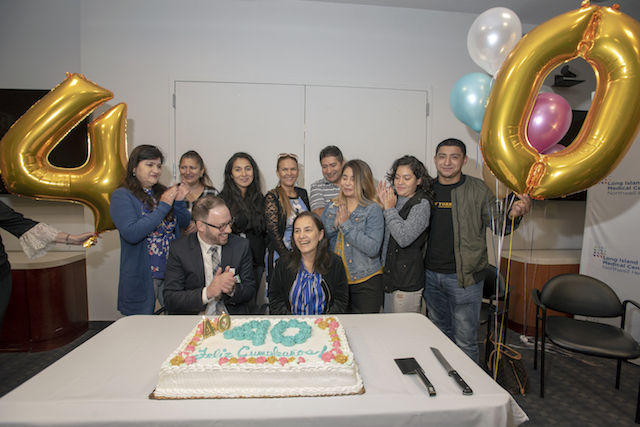Emma Barros, who originally hails from Ecuador and now resides in Brentwood, reached a milestone that she feared she’d never live to see — the celebration of her 40th birthday with her loving husband and daughter, and 10 of her closest family members.
Joining in the family celebration at Long Island Jewish Medical Center was Dr. Gary Deutsch, the innovative surgeon who realized that Barros was the perfect candidate for a complex surgery known as the Whipple procedure to cure pancreatic cancer. The challenge arose from Deutsch’s decision to utilize the da Vinci robot to remove a large tumor instead of going with traditional laparoscopic surgery.
Earlier this year, Barros visited her doctor complaining of severe stomach pain that, she learned, was caused by gallstones. Even after having them removed surgically in March, the pain returned with new symptoms — Barros turned a yellow hue from jaundice and suffered terrible itching.
Speaking through an interpreter, Barros said, “I didn’t want to believe anything was wrong. My husband told me I was turning yellow and I didn’t want to believe. I even asked my daughter and she told me it was true.”
Barros returned to the emergency department at LIJ and learned that a gallstone was stuck in her bile duct, causing a blockage. Her doctors hoped to remove the gallstone endoscopically and, to their surprise, Barros was found to have a large mass in the first part of the intestine. This unexpected finding was biopsied and revealed that Barros had pancreatic cancer.
At this point, Barros met Deutsch, a surgical oncologist who decided that the robotic Whipple procedure (named after the surgeon who pioneered its use) was a better way to go.
“The reasons for using da Vinci were many,” said Deutsch. “By operating robotically, we have better visualization with a high-definition 3D camera and more freedom of movement and dexterity. Also, such major abdominal surgeries traditionally resulted in longer incisions, more pain and scarring, and more recuperation time for the patient than da Vinci surgery. For Ms. Barros, we only needed to make five small incisions that are less than one centimeter in length. And, she was able to go home in four days.”
On Sept. 21, Deutsch performed the complex, 10-hour surgery — also called a pancreaticoduodenectomy — which involved the removal of the right side of the pancreas gland along with some of the surrounding intestine and a portion of the bile duct. She was back at home in less than a week, and was finally able to look forward to her 40th birthday.
Surrounded by her loving family and her surgeon, giant balloons and a birthday cake, Barros said simply, “It is such a blessing to be with my family today. This is a very special birthday.”



